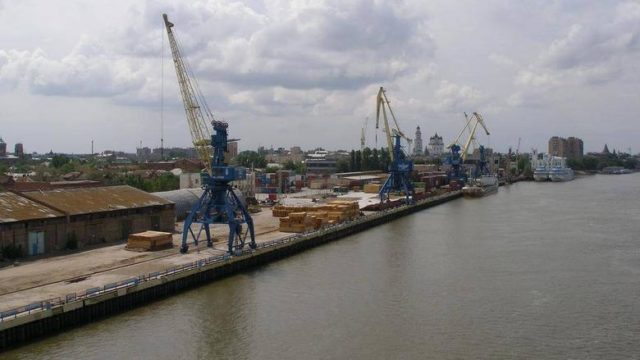
Kalmykia Seeks to Be a Player on the Caspian with New Port
Publication: Eurasia Daily Monitor Volume: 16 Issue: 119
By:

The Caspian Sea littoral countries are not the only entities involved in the competition over the use of that body of water and its links to the broader world: federal subjects of the Russian Federation are seeking to be players as well. Notably, Astrakhan region is currently trying to defend its position, having lost the right to host the Caspian Flotilla’s main naval base to Dagestan (Kaspiysk). In turn, Dagestan hopes to further build on its victory by expanding the North Caucasus republic’s main civilian port and develop new canal links to the Black Sea (Casp–geo.ru, December 5, 2018; see EDM, May 31, 2018 and August 7, 2018).
But while Astrakhan and Dagestan have long been active on the Caspian, Kalmykia, a Buddhist republic within the Russian Federation that also borders that sea, has not. For one thing, it has been hampered by the fact that it is a relatively poor region and currently lacks a deep-water port, the development of which would be prohibitively expensive. Moreover, Moscow has been reluctant to allow any ethnically homogeneous republic to develop extensive external ties—Kalmyks outnumber ethnic Russians two to one—as opposed to more diverse places like Dagestan, where the Russian government can maintain its position by a divide-and-rule policy.
Now, however, at least three important shifts are finally, creating conditions in which the Kalmykian authorities see an opportunity to make a breakthrough. First, and likely most importantly, the problems the Kremlin has with its regional naval fleet (something that has compelled it to shift vessels from the Caspian to the Azov Sea in order to threaten Ukraine) mean that the center is more interested than in the past in building a new canal system between the two bodies of water. The current route via the Volga–Don Canal is far longer and has more locks than a new canal would, if built through Kalmykia. Consequently, for security reasons, the Kalmyksare gaining support from the Russian navy, which would need a Kalmykian base on the Caspian in that case.
Second, Astrakhan is less attractive as a port than it once was. Ongoing impacts due to climate change mean that the approaches to the city’s docks are increasingly silting up, forcing the Russian government to dredge far more often than in the past and making transit from Astrakhan into open water or, via the existing canal, to the Sea of Azov far less reliable. Those difficulties have already contributed to the Russian navy’s decision to shift its main Caspian base from there to a new Dagestani facility (see EDM, July 17, 2018).
Finally, Moscow’s divide-and-rule approach toward Dagestan is not limited to internal republican politics but also involves pitting that increasingly unstable Muslim republic against its neighbors. As a result, many in the Russian capital are now prepared to look at Kalmykia not only as a route for a new canal system but as a counterweight to Dagestan and its problems. If Astrakhan is of declining importance and Dagestan is potentially unreliable because of internal unrest (Politikus.ru, July 7, 2018), the development of a Kalmykian port on the Caspian could provide Moscow with an insurance policy as well as an ally to play off against Makhachkala and the Muslim North Caucasus more generally.
Batu Khasikov, the head of Kalmykia, has jumped at the opportunity these shifts have seemingly created for his republic. The recent Caspian Economic Forum (see EDM, September 4), held on August 12, in Awaza, Turkmenistan, brought together not only the governments of the five littoral countries but also representatives of the Russian Federation’s Astrakhan, Dagestan and Kalmykia. And during this event, Khasikov said that the growing importance of the Caspian had convinced him Kalmykia needs to play an expanded role by developing its own port to allow for the transshipment of goods. Moreover, he promised to start allowing training for Turkmen and other students in the region at Kalmykian universities (Casp-geo.ru, August 16; mk-kalm.ru, August 13).
At least according to available news accounts, Kalmykia’s governor did not raise the issue of the construction of a new canal—that may be too militarily sensitive an issue at present for such public discussion by a regional official. He did, however, sketch out ways in which his republic could contribute to the development of the countries of Central Asia because of its experience with land amelioration and agricultural development. Kalmykia has great experience in this, he said, and it would only be too happy to share it with Turkmenistan and the other Central Asian republics.
Such an expansion of Kalmykian activities around the Caspian could help Khasikov’s republic grow economically, of course; but they would likely reignite the national movement there, one that has been quiescent in recent years after Kalmyk cooperation with the Germans in World War II led to their deportation (Joachim Hoffman, Deutsche und Kalmyken 1942 bis 1945, Friedberg, 1986; Stephen Halkovic, Jr., The Mongols of the West, Bloomington, 1985). How far all this will go and how Moscow will react are far from clear. But one thing is certain: there is a new player knocking on the door of the increasingly important Caspian Sea region, one that few have given much attention to up to now.



